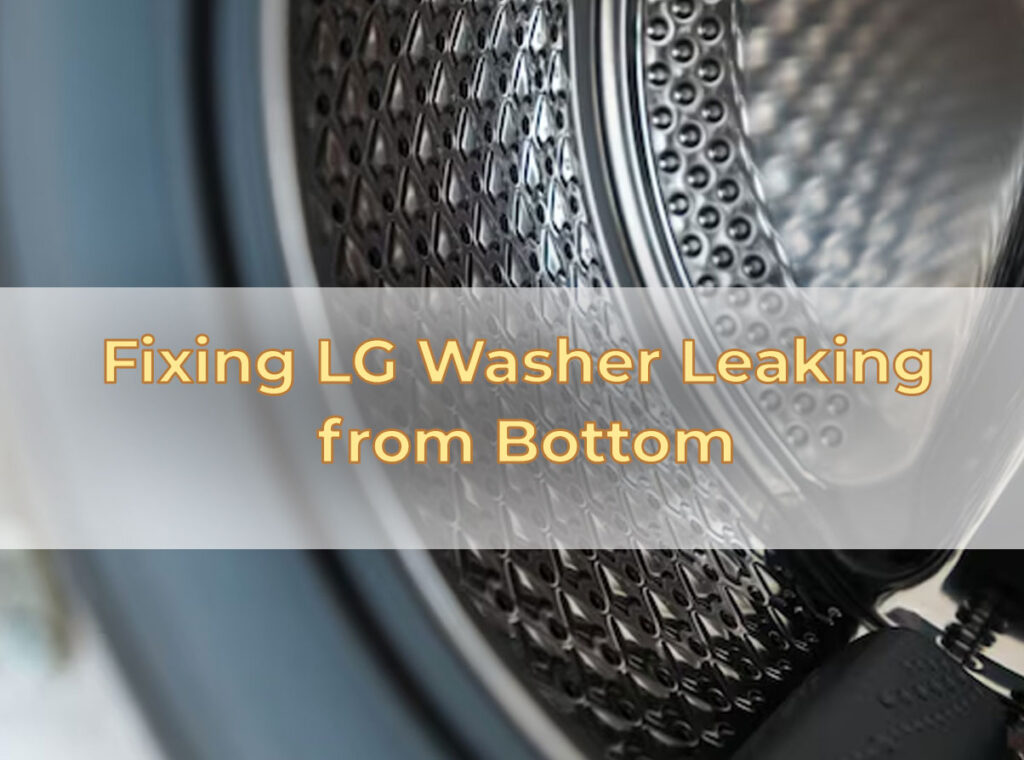If you have an LG Washer leaking from bottom, it can be frustrating and worrisome. A leaky washer can cause water damage to your floors and walls, not to mention the cost of replacing a damaged machine.
However, there are some simple steps you can take to troubleshoot the problem and prevent further damage. Here we discuss the common reason why LG washer leaking from bottom and how to resolve the problems.
Why is my LG Washing Machine Leaking Underneath?

Leaks from the bottom of an LG washing machine could come from many different causes. Most likely, a worn or broken part is the cause. Here we are going to compile the common reason why LG washing machine leaking underneath.
1. Faulty water inlet valve
If you have noticed your LG washing machine leaking from the bottom, it could be due to a faulty water inlet valve. The water inlet valve is responsible for controlling the flow of water into the washer during the wash cycle. If it malfunctions, excess water can leak out and cause a mess.
There are a few signs that indicate a faulty water inlet valve. These include excessive noise during operation, slow or no fill of water in the drum, and leaks from underneath the washer.
2. Worn or damaged hoses
Hoses play a crucial role in the proper functioning of your washer, and any wear and tear can lead to leaks. A leaky washing machine not only causes water damage but also results in high water bills. So, it’s essential to address the issue as soon as possible.
The first thing you should do when you notice leaking is to turn off the power supply and unplug the washer from its source. Next, check if there’s any visible damage to the hoses located at the back of the machine.
Hoses can be damaged due to various reasons such as age-related wear and tear or accidentally getting caught on sharp corners during installation. If you find any cracks, kinks, or bulges on hoses, it’s best to replace them immediately before they cause any further damage.
3. Loose or damaged pump
One of the most common reasons for a loose or damaged pump in an LG washing machine is wear and tear on the part. Over time, pumps can become worn down and start to malfunction, causing leaks.
Additionally, if the machine is moved frequently or roughly handled during transport, it can cause damage to the pump that leads to leaks.
4. Overloading
Overloading puts excessive pressure on the internal parts of your washing machine, causing them to wear down faster than they normally would. This can lead to leaks from various parts of the machine – including the bottom – which can be frustrating to deal with.
In addition, when you overload your washing machine, it doesn’t allow enough space for proper water circulation during a wash cycle.
This lack of circulation means that some areas of clothing may not get properly cleaned or rinsed off, leading to mold growth and unpleasant odors in your clothes.
5. Faulty door seal
A damaged or worn-out door seal can cause water to leak from the washer’s bottom, creating a mess on your floor and potentially damaging nearby appliances or furniture. Door seals are responsible for keeping water inside the machine during wash cycles and preventing it from leaking out.
Over time, due to regular wear and tear or accidental damage, these seals can become ineffective at performing their job correctly. If you notice any signs of leakage from your LG washer’s bottom, it’s essential to inspect its door seal immediately.
Fixing LG Washer Leaking from Bottom

Here are some tips on fixing LG washer leaking from Bottom on your own:
1. Inspect the hoses
Firstly, turn off the water supply to your LG washer and unplug it before attempting any repairs. Then, locate the hoses located at the back of the machine that connect to both hot and cold water outlets.
Check for any visible cracks or damage along each hose’s length and ensure they’re tightly secured to both connections.
Next, inspect where each hose connects to your washer’s drum for signs of wear or damage. If you notice any issues with either connection, replace affected hoses immediately as they’re likely causing your LG washer leak from bottom.
By taking regular preventative steps like this, you’ll save yourself costly repair bills down the line while keeping your laundry room dry! Check also why dryer is making rattling noise
2. Check the water inlet valve
Locate the valve at the back of the machine where hoses attach. Remove these hoses and inspect them for any cracks or signs of wear and tear. If they are damaged, replace them before proceeding further.
Next, use a multimeter to test whether there is continuity between the two terminals of the valve when power flows through it. If there isn’t continuity, then your water inlet valve needs replacement as it’s not functioning correctly. Check also Why is My Water Yellow.
3. Inspect the pump
Remove any clothing or other items from inside the drum and locate the pump at the bottom of your machine. Check for any obvious signs of damage or wear on the pump itself or any hoses leading to it. Additionally, look for any debris that may be blocking the flow of water through the pump.
If you notice anything out of place during your inspection, take necessary steps to fix it before attempting to use your washer again.
4. Check the door seal
Locate the rubber door seal of your washing machine. Check for any visible signs of damage such as cracks or tears. These damages can cause water to leak out of your machine during its cycle.
If you spot any damages on your door seal, it’s important to replace it immediately. You can purchase a new seal online or at an appliance store and install it yourself by following manufacturer instructions carefully.
5. Clean the drain pump filter
Locate the small door near the bottom of your washer and remove it carefully using a screwdriver. Look inside for a small hose attached to the drain pump filter cap; unscrew this cap slowly to avoid spillage. Make sure you have towels ready to catch any excess water that may flow out while removing the cap.
6. Check the leveling
Examine all sides of your machine and check if it sits evenly on the floor or wobbles at any point. If there is an unevenness in its position, try adjusting each foot individually until you achieve balance across all edges.
It’s important to note that this simple fix can save you time and money by preventing further damages caused by water leaks which could lead to more extensive repairs down the line.
Where do washing machines usually leak?

Washing machines can leak in various places, depending on the issue. Sources of the leak could include hoses, valves, pumps, seals and more. It is important to spot where the leak is coming from so it can be fixed.
Common places for washer water leaks:
- Front and back – Often caused by door seals, lint filters and hoses.
- Bottom – Could be from a clogged or broken gasket.
- Connectors – Could be due to loose parts, worn out rubber hoses or not being tightened enough.
- Water inlet valve – Faulty valve that isn’t seating right or needs replacing.
- Drain pump – Obstruction like a hairpin or faulty internal components like bearings or seals.
Fixing lg washer leaking from bottom top load
The most common cause of an LG top load washer leaking from the bottom is an improperly fitted water hose. Find the source and confirm it’s water. Shut off both cold and hot water valves and unplug the machine. You might need to turn off other power sources or open the lid to inspect hoses.
Once located, disconnect both hot and cold hoses. Check for damage or wear on fittings. If stress or wear has caused a hole, replace the fitting. To stop the leak, run a new threaded fitting through each end of the hose. Take caution when tightening them down. After that, run a test cycle with the valves open.
Fixing lg washer leaking from bottom front load
If your LG front-loading washer is leaking from the bottom, there could be several causes. The most common one is if the drum is over-filled or if the load is unevenly distributed. The remedy is to spread out the clothes evenly and not over-fill it.
Other possible sources of leakage need more involved troubleshooting, or even parts replacement. These include:
- Blocked drainage – Clothes collecting at one side of the tub during a cycle can mean your drain hose is blocked or kinked. Unplug the washer and disconnect/reconnect the hose to clear blockages or kinks.
- Pump failure – If the washer remains overfilled with water after redistributing the clothes, the pump may need servicing or replacing. Remember to unplug power cords before servicing any appliance.
- Worn seals – Rubber seals on older models can become brittle and leak over time. Seal replacement requires mechanical experience and unplugging power cords before servicing.
fixing lg washer leaking from bottom left corner
Is your LG washer leaking from the bottom left corner? Check the water supply hoses for a tight connection. Use an adjustable wrench if loose. Inspect the drain hose for a clog or blockage. This could cause a backup and leakage.
Look at the tub seal at the back of the washer. Cracks or breaks can cause leakage. Replace the seal with a new one from an LG parts supplier, if needed.
Check all the exterior seals. Loose seals can result in water seeping out. Inspect for any cracks or wear and tear. This could allow moisture to escape out of the appliance and onto the floor.
By following these steps, you can quickly determine the cause of the leak on your LG washer.
Fixing lg front load washer leaking from detergent drawer
If there’s water leaking from the bottom of your LG washer, it’s probably from the detergent drawer. It’s easy to fix. Here’s what to do:
1. Unplug the washer, ensure it’s drained and turn off the water source. Remove any water with a sponge or vacuum.
2. Remove the detergent drawer by prying it out. If needed, unscrew bolts or fastenings. Look for signs of leakage like soapy residue or rust stains.
3. Clean all surfaces around where you removed the drawer. Dirt can cause malfunctions over time. Don’t clean with liquid as it can cause electrical issues. Let an experienced professional do it.
4. Re-install parts as they were before. Use enough force so they stay secure. Double check all mounting points for crumbling rubber seals.
5. Tighten screws/fasteners until snug. Plug into power outlet and add load size. Your washer should now be sealed and leak free. Enjoy! Check also: Frigidaire Dishwasher Not Starting
Is it safe to use a leaking washing machine?
No, Using a leaking washing machine is risky. It can cause harm to the washer, your home, and you! Don’t be tempted to save money by using a leaking washer. Safety first.
If a leak can’t be located, or has been present for some time, it needs to be fixed by a pro. A pro can tell you what steps to take to prevent a similar issue, and what to do about potential damage already done.
Can a leaking washing machine be fixed?
Yes, you can fix a leaking washing machine.
Inspect components inside your machine such as tub gaskets, door seals, and drain lines. Gaskets shouldn’t have any visible cracks due to regular wear and tear. If they are present, replace them with factory-approved replacements. Additionally, get rid of debris from within tubs and channels in your washer’s door.
Finally, keep up pre-check maintenance on washing machines prior to use. This will help reduce costly repairs in the future. Check hoses for weak areas regularly, and clean lint filters when needed.
Can a blocked filter cause washing machine to leak?
Yes, a blocked filter can cause washing machine to leak. Check and clean the filter regularly. A blocked or damaged filter can lead to leaks.
If the filter is not blocked, then something else is causing the leak. Look for signs of damage on hoses connected to the pump. Or a blocked drain valve. Modern machines could have an internal component malfunctioning. Fix these yourself if you can. But if you’re unsure, call an experienced technician.
What are the symptoms of dirty filter?
A blocked filter in an LG washer could lead to strange noises, poor performance, and water leakage. Check if your machine has the filter feature. If it does, too much lint or dirt can cause a blockage. This can cause the motor to overheat, louder noises, and water leakage.
Clean and/or replace the filter if needed. If unsure, contact a professional for help.
Should you change your filter every time?
Yes, you should change your filter regularly. It is wise to replace the filter of your LG washer every 6 months or so. This depends on how often you use it. The filter helps the washer work properly by collecting lint and debris from the tub and drain hoses. If not regularly removed, these can clog up the machine and reduce water pressure. This can even cause a leak.
“There is no real ending. It’s just the place where you stop the story.”






